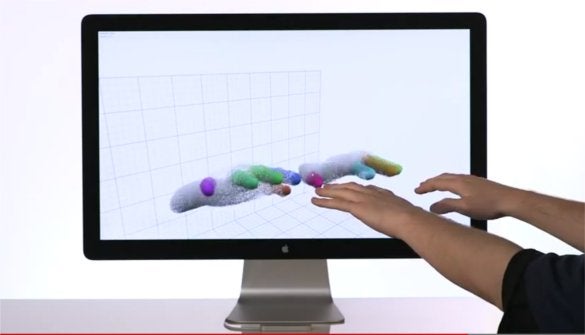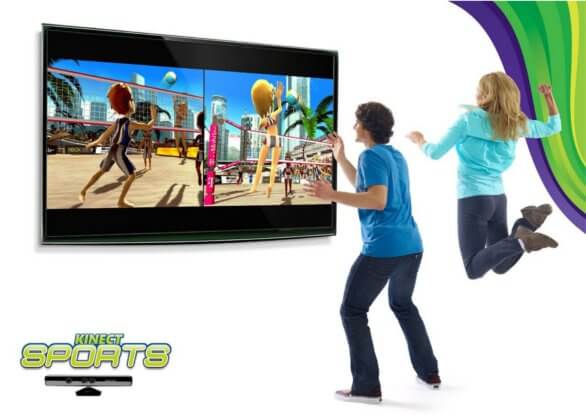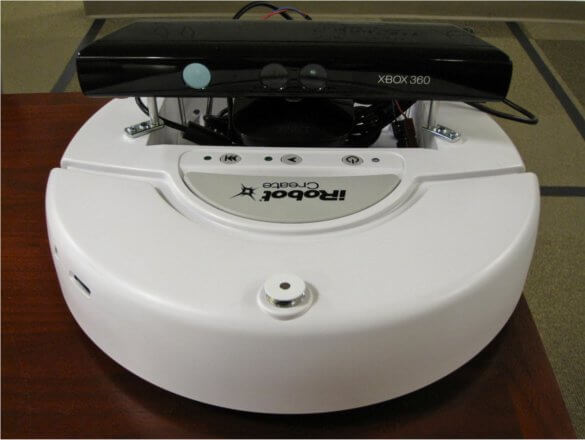Founders of Leap Motion: Our Amazing 3D Tracking Will Be Everywhere

Share

In the short time since its debut, the Leap Motion has inspired zombie-like devotion in many gadget lovers, but can the device live up to the hype? (Yes, yes it can).
In the past few weeks the Leap Motion device has sent shudders of delight through gadget lovers and computer designers alike by promising a new kind of ultra-accurate, and very cheap, optical 3D tracking for your desktop or laptop computer. Forget the Kinect, Leap Motion is cheaper ($70), more precise (down to 0.01 mm), and much smaller (think “pack of gum” proportions). The incredible demo for the Leap Motion (see below) shows how the desktop device can quickly detect hand motion so that a user needs merely wiggle their fingers in front of their computer to intuitively control what happens on the screen. Currently taking pre-orders, the Leap Motion is scheduled to ship between December and February, and with it will come a new market of third party apps designed to take full advantage of the device. I had a chance to sit down with CEO Michael Buckwald and CTO David Holtz and test out the Leap Motion first hand. If things go their way, the Leap Motion will become the “third input device” for computers, joining the keyboard and mouse in a new triumvirate of digital control.
For those who missed earlier coverage of the Leap Motion's debut here's the official promo video for the 3D tracking device:
While at their HQ, Singularity Hub got a lot of raw footage of the device in action. The following video is silent, but you can see many of the demos in much greater detail. Notice that the Leap Motion used here, and in all press demonstrations, is a prototype that is slightly larger than the form factor that is being sold. It is the flat black box laying in front of the keyboard. The commercial unit will also connect via USB (not wireless), and will be smaller, silver, and lighter weight. Buckwald and Holtz said they could conceivably make the Leap Motion even smaller (the size of a large coin) but they think this size/weight is best for a $70 device that you don't want to lose easily.
If someone can watch the demonstration of Leap Motion and not feel their jaw dropping they probably don't understand how extraordinary this technology really is. That's okay, I didn't either at first. Buckwald and Holtz explained that the magic of Leap Motion isn't the array of infrared sensors and IR LED lights that are contained inside the sleek form factor – those are all cheap components from China. The secret sauce is software, specifically the algorithms developed by Holtz that convert those IR signals into a well crafted 3D picture of what's happening in front of the Leap in real time.
It's hard to summarize those algorithms in any other way besides this: they are really, really good. The mid-range performance computer seen in our raw demo footage was spending just 5% processing power to run the Leap Motion software, yet it was tracking finger motions down to sub-millimeter precision and at speeds that excel anything I could achieve even after drinking a dozen Red Bulls.
The incredible thing is, as Holtz says, they are only “about 50%” of where they will eventually be when the Leap Motion launches this Winter. That's not a comment on how much they have left to do to get ready, it's a comment on how far they aim to exceed everyone's expectations when they hit market. Time and again during our interview, Buckwald impressed upon me that Leap Motion was squarely focused on creating a base experience that was so well-crafted, so robust in execution, that it would be an unequivocal boon to users.
Part of that base-experience is the 3D motion tracking that you see in the demos. The unseen part of the equation is the Leap Motion API that accompanies the device. With that API, third party developers will have a very reliable, very flexible means of communicating with the Leap Motion. The company has already pursued dozens of high-end developers to create marketable apps to be released with the product's launch. All size developers, however, are welcome to request a free SDK from the company, and Buckwald says he is ready to hand out “thousands” if not “tens of thousands” of developer devices to help create the initial wave of apps. The goal is to have a “Leap Motion Market” thru which developers can sell their wares, and which will generate revenue for Leap Motion by taking a small slice of the profits. Everyone seems likely to be invited to that market, from amateur freeware enthusiasts to hardcore app developers with premium services to offer.
What forms will those apps take? Some are easily suggested by the demos. The Leap Motion could work as a new means of navigating maps and other 3D digital spaces, it could be a fun game controller, it could even serve as a handwriting to text recorder. Holtz was originally inspired to develop the earlier versions of the device because there wasn't a good way to handle 3D sculpting and modeling – there's another great app idea. The greatest part of the 3D market space, however, is yet to be explored. That's as it should be, because it will take the industry a while to really understand for what kind of applications this hyper-accurate short range 3D tracking is best suited.
When it first came out, the Kinect was marketed as a “revolution” in gaming, with full-body tracking and “intuitive controls” for the Xbox 360. But that turned out to be silly. Game developers have yet to produce a Kinect title that I really enjoy, and the coolest applications I've seen for the device are as cheap long-range sensors for mobile robots, and one-to-one controls for humanoid machines. Buckwald and Holtz don't want to create a similar device, or user market, wherein costumers buy the product, play with it for a few days, and then put it down because it's not practical. The grand challenge is to make the Leap Motion an integral part of how you use your computer.

This was the promise of the Kinect - 3D tracking would transform your whole body into a game controller. In actuality the experience is kind of meh.

The real innovations provided by the Kinect could be cheap 3D sensing for robots. Could the Leap Motion ultimately make a similar turn in its development?
So then, what's the real application space for the Leap Motion? I'm happy to say I don't know. It could allow for a computer control system like that seen with Minority Report, but most of us don't need to pour through visualized 3D data. It could be a cheaper way to integrate touchscreen-like controls without the actual touching (no smudges!). Leap Motion could be all about high-speed gesture controls for those times when you need to quickly mute videos, swap between windows, or answer a chat. Hell, for all I know Leap Motion could be the next big thing in porn. It's anybody's guess.
Be Part of the Future
Sign up to receive top stories about groundbreaking technologies and visionary thinkers from SingularityHub.


Rest assured that Buckwald and Holtz are preparing for everything and laying some truly impressive groundwork for all future development. While the learning curve is severe for each demo I tried, there was little doubt that the Leap Motion knew exactly where I was and how I was moving my hand. The core technology (the tracking algorithms) is well beyond what we need, and they're continuing to improve it. The API is open and free to develop, and they're actively seeking to enrich that community. They have a small (~22) dedicated team working on making sure that come six months from now, when you unwrap your Leap and plug it in, you'll use it as if it's always been a part of how you control your computer.
Considering the fickleness of the gadget market, that's a hefty dream. The Wii, the Kinect, and the Playstation Move have all tried to reinvent game controllers but seem to fail as often as they succeed. Touchscreens are moving to dominate the mobile market, but aren't well suited to the desktop/laptop space. All the fancy optical gesture control schemes we've seen crop up in the last few years are impressive, but they're not household names. At least not yet. Leap Motion wants to be more than any of these previous attempts at redefining human-computer interaction.
Perhaps that won't happen at the desktop computer at all. Buckwald says they are in talks with many different potential OEM partners to see how modified IR sensor arrays could be created so that Leap-like tracking could be performed in many different spaces. Why not Leap controls in the car, on your mobile device, or in your kitchen appliances? Holtz had dozens of long-term concepts where the efficient and powerful Leap algorithms might be applied. One of the best was as the controls for a head mounted display (does Google Glasses need a partner?). Anywhere you can place some IR LEDs and sensors, Leap Motion can be there.
The bottom line is that Leap Motion has millions in funding ($15M to be exact), an amazing pre-market device, and tons of positive press. Their core technology is sound, their vision for a developer market is laudable, and they're in a market ripe for innovation. This is as sure as things get in Silicon Valley. Buckwald says they're on target to sell hundreds of thousands, if not millions, of Leap Motion devices in the next year. I believe that will happen. He and Holtz also think that the Leap version of 3D tracking and control could be everywhere in the future. I want to believe that too...but I'll wait until Winter to say for sure.
Buckwald and Holtz were pretty tired when we spoke (ground-breaking input devices apparently take very long hours) but they let me record everything we talked about. I'll leave you with the video of our conversation where they both discuss the Leap Motion in greater detail.
Images: leap motion, kinect/microsoft, ros
Source: michael buckwald and david holtz / leap motion
Related Articles

How Scientists Are Growing Computers From Human Brain Cells—and Why They Want to Keep Doing It

These Brain Implants Are Smaller Than Cells and Can Be Injected Into Veins

This Wireless Brain Implant Is Smaller Than a Grain of Salt
What we’re reading